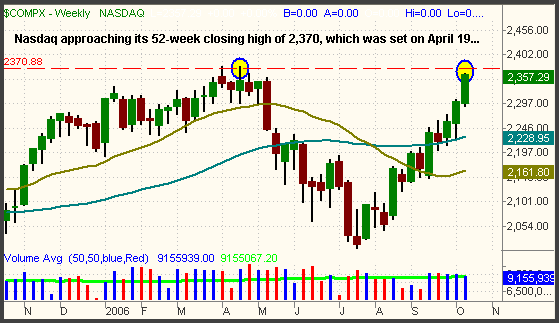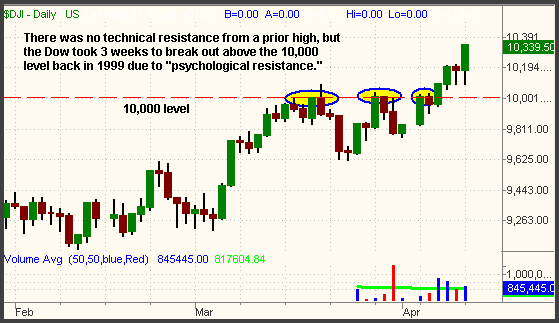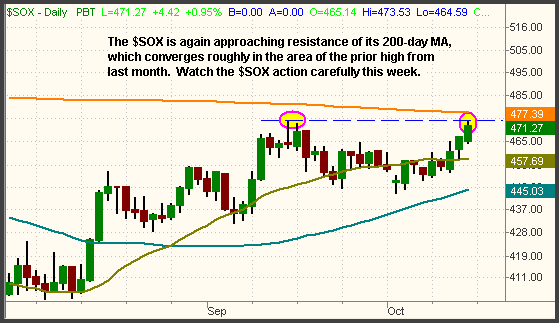The broad market grinded higher throughout last Friday's session, capping a strong week for the major indices. Both the Nasdaq Composite and small-cap Russell 2000 indices again showed leadership by gaining 0.5% and 0.7% respectively. The S&P Midcap 400 matched the performance of the Nasdaq by rallying 0.5%, but the Dow Jones Industrial Average took a breather and eked out only a 0.1% gain. The S&P 500 advanced 0.2%. Tech and small-cap growth stocks, laggards since the S&P and Dow rally began in July, began showing relative strength last week and are quickly "catching up" to the other indices. This is apparent by comparing the weekly performance of the major indices. The Russell 2000 zoomed 3.1% higher and the Nasdaq cruised 2.5% higher last week, but the S&P 500 "only" gained 1.2%. The Dow's 0.9% gain was more subdued, but the index has been leading all the other indices since bullish reversal began three months ago. The Dow also finished at its highest level of the week, again setting a fresh record high.
Overall volume in the NYSE was 4% lighter than the previous day's level, while volume in the Nasdaq declined by 3%. It was the second straight day of gains on lighter volume, but at least turnover in both exchanges exceeded 50-day average levels. The gains on lower volume prevented the major indices from registering a bullish "accumulation day." This was also the case last Thursday, when the Nasdaq and S&P 500 gained an impressive 1.6% and 1.0% respectively, but did so on lighter volume. Market internals were solid in the Nasdaq, as advancing volume exceeded declining volume by a margin of 2.7 to 1. The NYSE ratio was positive, but only by approximately 3 to 2.
Going into this week, there are several technical factors that could provide a good excuse for stocks to correct or at least take a break. Perhaps the most important is the Nasdaq's upcoming test of resistance at its 52-week high. As you know, both the S&P and Dow are well beyond their prior highs from May, but the laggard Nasdaq has only now rallied up to that pivotal level. As illustrated on the weekly chart below, the Nasdaq finished last week only 0.5% below its closing 52-week high of 2,370 that was set on April 19:

Because a 52-week high is always a closely-watched level, expect a lot of volatility this week. Many stop orders are likely to be found in this vicinity of the Nasdaq's high, which would result in whippy intraday trading action. If you're long the Nasdaq and are planning to sell into strength, now is a great time to do so. At the very least, tighten your trailing stops using intraday trendlines and support/resistance levels. Sure, the Nasdaq could easily break out to a new high, but you can simply re-enter your positions on the first subsequent pullback.
Another factor that could provide the "cause for a pause" is the Dow's impending test of the 12,000 price level. Curiously, the actual 12,000 level does not provide any technical resistance because the Dow is at an all-time high. But large, round numbers always act as "psychological resistance" that becomes a self-fulfilling prophecy when traders sell into those numbers. Back in 1999, for example, I remember the first time the Dow approached the 10,000 price level. Like the present time, the Dow was trading at an all-time high, so there was technically no overhead resistance. Nevertheless, the index tried and failed to break above the 10,000 level for a three-week period before finally doing so. This is illustrated on the daily chart of the Dow from 1999:

When the Dow initially approached the 10,000 level, all the financial media outlets such as CNBC and Bloomberg were hyping the possibility of the Dow trading over 10,000 for the first time ever. Had that not been the case, the Dow probably would have popped over 10,000 much faster than it did, but all the hype created a self-fulfilling prophecy of "psychological resistance" that held the Dow below 10,000 for three weeks. Over the weekend, we read a lot of hype about the Dow being near the 12,000 level, so we believe this is likely to cause a bit of resistance for the Dow. The index closed last week at 11,960. so we could see that probe above the 12,000 level as early as today.
The Semiconductor Index ($SOX) is once again approaching resistance of its 200-day moving average, which also converges with resistance of its prior high from last month. This laggard index began to show signs of life last week, but keep a watchful eye trained on that 200-day moving average. As the $SOX goes, the Nasdaq tends to follow, so be on alert for a reversal of the $SOX at its 200-day MA:

Finally, remember that the S&P 500 is sitting right at its 76.4% Fibonacci retracement level from it March 2000 high down to its October 2002 low. As discussed in the October 13 issue of The Wagner Daily, this is the "last line of defense" that could stop the index from following the Dow by blasting off to a new record high. Momentum has pushed both the S&P and Nasdaq above the upper channel of their uptrend lines on the daily charts, which has caused our near-term bias to become neutral to bearish, but the charts of the S&P and Dow give us every reason to remain bullish on the intermediate term. Don't forget that quarterly earnings season is also kicking into full swing and could provide yet one more reason for excessive volatility in the short-term.
Deron Wagner is the Founder and Head Trader of both Morpheus Capital LP, a U.S. hedge fund, and Morpheus Trading Group, a trader education firm launched in 2001 that provides daily technical analysis of the leading ETFs and stocks. For a free trial to the full version of The Wagner Daily or to learn about Wagner's other services, visit MorpheusTrading.com or send an e-mail to deron@morpheustrading.com.